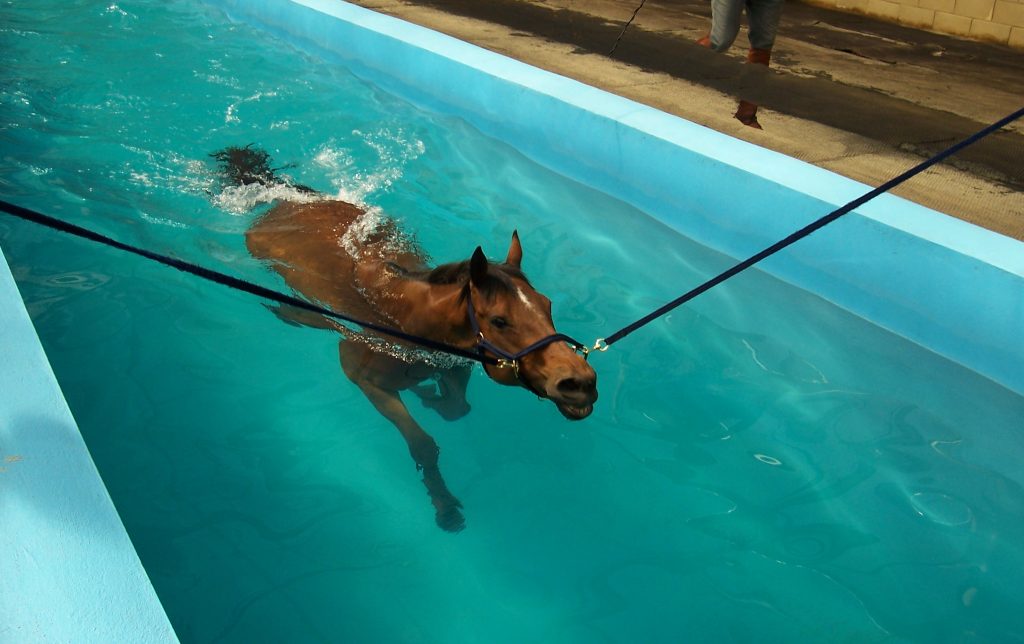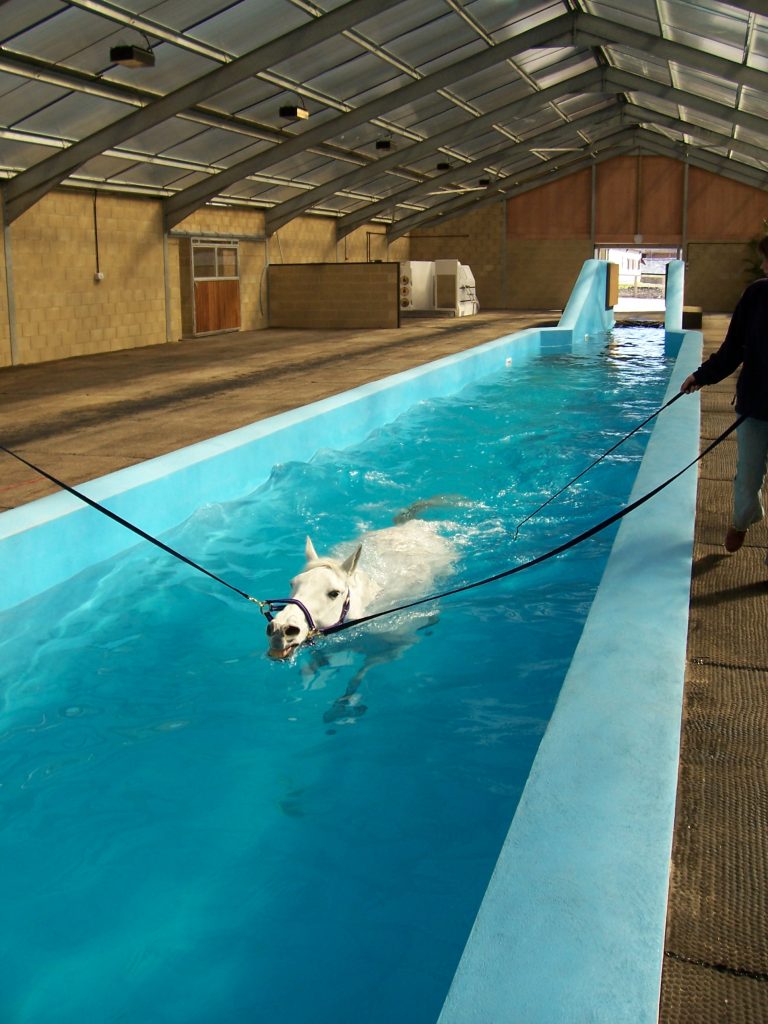
By: Liz Newman
Hydrotherapy is the blanket term used to describe all types of therapy involving water for humans as well as horses. This can be rather confusing for horse owners and trainers unfamiliar with the various types of hydrotherapy and their purpose. This may include everything from simply cold hosing a horse’s legs after work, standing in a cold water spa to reduce swelling and pain or treat specific conditions of the horse’s lower leg or hoof, walking on a treadmill submerged in water or doing laps in a pool. Both the water treadmill and the pool improve muscle aerobic capacity and strength, reduce stress on limbs and joints, reduce pain and inflammation and increase cardiovascular endurance.
The buoyancy and resistance of the water reduces the level of weight bearing on joints, tendons and ligaments. Immersing a horse in water increases extra-vascular pressure through compression which improves circulation and reduces oedema. A fit horse has less chance of injury and more chance of success. To achieve fitness you must address all physical components of the horse including respiratory, cardiovascular, muscular as well as tendons, ligaments and bones. Swimming allows a horse to be conditioned in an almost completely buoyant environment, therefore without weight bearing, it is excellent for conditioning all of the above except bone.
For fitness training swimming does not replace ridden work which is needed to strengthen bone but for peak fitness swimming is superb. Recent research shows that a horse swimming for 5 – 8 minutes can increase a horse’s heart rate from 34 to 175 beats per minute. This is close to the 200 beats per minute experienced by a horse breezing over 4 furlongs on the track. Swimming a horse for 15 minutes is the same as galloping a horse, unencumbered by a rider, for 5 miles, from a conditioning perspective.
Swimming is also excellent for rehabilitating horses following an injury, especially for tendon and ligament injuries where buoyancy dramatically reduces the chance of re-injury. When a horse is injured it has a huge impact on his or her daily routine. No paddock time, endless stall time and hand walking becomes boring very fast. Swimming is a great way for the horse to exercise, let off steam and relax both mentally as well as physically and in some cases remain sane !

Swimming for fun is great for horses. It sweetens up those bored with the repetition of the daily training regime and gives them the opportunity to move freely in a buoyant environment.
In some situations, swimming should be avoided. Any horse that has had surgical intervention should not be swum until the injury site has fully healed. Horses who have pelvic and back injuries, including those that have had surgery for kissing spine should also not swim. In this situation the water treadmill is an extremely useful tool for improving general fitness and rehabilitation following injury or surgery.
Horses should be encouraged to walk in a long low outline on the treadmill, which will improve topline and hind muscles. The treadmill increases the horse’s stride length while reducing stride frequency and the water resistance encourages respiratory, muscular and tendon improvement. The buoyancy of the horse is relative to the water level, which can be increased or decreased as appropriate, as can the gradient of the treadmill platform.
A common condition found in all performance horses, including racehorses, is joint disease. A large part of lameness diagnosis and treatment concerns joint disease. Dr. Svend Kold, Orthopaedic Surgeon and Senior Veterinary Surgeon at Ascot racecourse in England, believes that the key to successful management of joint disease, whether traumatic or degenerative, is early and aggressive interference.
If treatment is not instigated early and effectively, a traumatized joint unfortunately often remains inflamed and the inflammatory cascade soon spirals like a snowball down a mountain. The ‘slippery slope’ of joint degeneration towards osteoarthritis where we still have no options of treatment and certainly have lost the horse from racing’. In respect of rehabilitation following joint disease treatment; Svend has equally strong views on rehabilitation of joints following either surgery or joint injections. He strongly believes that training of athletes should never be stopped but altered and targeted to the rehabilitation needs of the injured structure(s).
Turn-out in paddocks does not figure in this regime, because it is non-controllable and non-quantifiable. Alternatively, controlled exercise, initially swimming and then additionally water treadmill, are used to ‘tease’ the injured structure(s) back to work as soon as possible and under the same loading pattern as will be required when in full training.
I have used equine hydrotherapy to prevent and rehabilitate injuries as well as to condition performance horses from racing, polo, jumping and eventing for more than 25 years. I built the first full service state of the art equine hydrotherapy centre in Europe 15 years ago. During this time I have been able to develop training techniques that maximize the benefits of hydrotherapy for optimum fitness and performance. Having seen over the years a myriad of injuries, both at the time of injury and at the post-operative or rehabilitation stage, I have developed bespoke treatment regime protocols for swimming, the water treadmill and the cold water spa.
There is no doubt that hydrotherapy treatments –
● Prevent injuries
● Rehabilitate injuries safer and faster
● Enable horses to obtain a higher level of fitness
Equine pools and the use of water treadmills and cold water spas is now common practice with racehorses in England, Europe, Australia and New Zealand, the Gulf states, Japan and other countries in the Far East.
I strongly believe that the provision of hydrotherapy facilities to all Thoroughbred racehorses would help to produce healthier and fitter horses and prevent many injuries.
Liz Newman
Co-founder and CEO Horse Homes
www.horse-homes.com
Consultant Disrupt Equine
www.disruptequine.com
Liz was born into a racehorse owning family, trained and competed show jumpers as a teenager and has spent 40 years working in all areas of the horse industry. She currently heads Horse Homes, where the team design and project manage the construction of equestrian facilities. She also acts as a consultant to Disrupt Equine helping entrepreneurs and established companies develop their ideas for new products aimed at the equine space.



